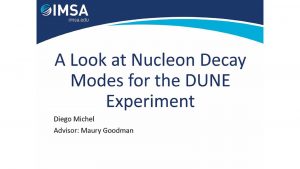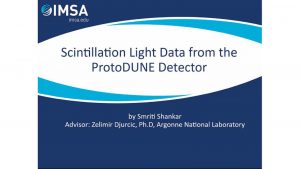From Argonne National Laboratory
June 29, 2021

Advancements in the multi-lab DUNE experiment by science, technology, engineering, and mathematics (STEM) researchers and students at Argonne will help scientists better understand neutrinos and the universe.
The U.S. Department of Energy’s (DOE) Argonne National Laboratory is proud to contribute to the ongoing Deep Underground Neutrino Experiment (DUNE). This international, multi-billion-dollar project, encompassing multiple national laboratories, brings researchers worldwide together to investigate one of the universe’s true mysteries: the nature of neutrinos.
Some of the youngest of the hundreds of researchers on the DUNE experiment are high school students at the Illinois Mathematics and Science Academy (IMSA). IMSA partners with the lab each year for a yearlong research experience, and some students have participated in DUNE-related projects for multiple years.
“DUNE will encompass decades-worth of data from countless contributors. So it is appropriate for high school students to have the chance to work on DUNE’s early stages, and possibly see the results come out as they progress through their careers.” — Maury Goodman, Argonne physicist

Argonne is part of an ongoing, collaborative experiment across multiple national labs to produce the world’s largest particle detector for DUNE. “The main goal of DUNE is to look at long-baseline neutrino oscillations, or how these infinitesimal subatomic particles with no electric charge transform over time,” explained IMSA student Smriti Shankar. “Understanding neutrinos will help us understand more about stars and space in general, but about the very start of the universe.”

Shankar began working with data from a DUNE prototype in conjunction with researchers from Argonne two years ago, and she decided to continue her research this year to carry on her unfinished work in particle identification methods. “My project came to a premature end last year, so I wanted to improve on what I had already done,” she said.
This year, Shankar reached a preliminary conclusion by using different types of light signals to better identify particles. “This experiment can be easily replicated with more data points, so it can potentially be used when the DUNE detector begins taking data,” she said.

Over two years of research at the lab, DUNE has broadened the horizons of IMSA student Diego Michel, who has researched potential ways that particles can decay in DUNE while surveying the vast possibilities of science, technology, engineering, and math (STEM) research. “This research has helped me get a hands-on take on science that I’d never have been able to get otherwise,” he said. “I also got to look at one of the frontiers of modern physics, which has helped me grow in the direction I want and develop into my full potential as a STEM researcher.”
After high school, Michel intends to study physics in college while also planning to stay engaged on the frontier of physics research. Shankar — who graduates from high school this year — plans to study electrical and computer engineering at Worcester Polytechnic Institute this fall. “As an engineer, I hope to be involved in future cutting-edge physics experiments,” Shankar said. “Leaving Argonne, my interests have developed into paths I don’t intend to abandon. I’m now surer than ever that STEM is right for me.”
Each experiment and advancement with DUNE helps move the project forward step by step, including the achievements of IMSA students. “DUNE will encompass decades of data from countless contributors,” said Argonne physicist Maury Goodman, who has mentored some students conducting research for DUNE. “So it is appropriate for high school students to have the chance to work on DUNE’s early stages and possibly see the results come out as they progress through their careers.”
The DOE Office of Science’s Office of High Energy Physics provides funding for the Deep Underground Neutrino Experiment.
Argonne National Laboratory seeks solutions to pressing national problems in science and technology. Argonne, the nation’s first national laboratory, conducts leading-edge basic and applied scientific research in virtually every scientific discipline. Argonne researchers work closely with researchers from hundreds of companies, universities, and federal, state, and municipal agencies to help them solve their specific problems, advance America’s scientific leadership, and prepare the nation for a better future. With employees from over 60 countries, Argonne is managed by UChicago Argonne, LLC, for the U.S. Department of Energy’s Office of Science.
The U.S. Department of Energy’s Office of Science is the single largest supporter of basic research in the physical sciences in the United States and is working to address some of the most pressing challenges of our time. For more information, visit https://energy.gov/science.


